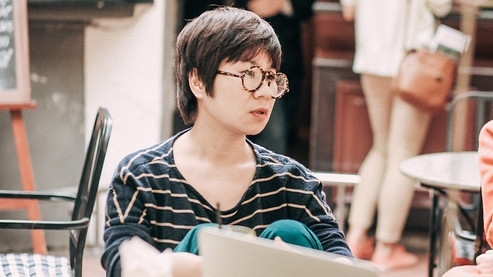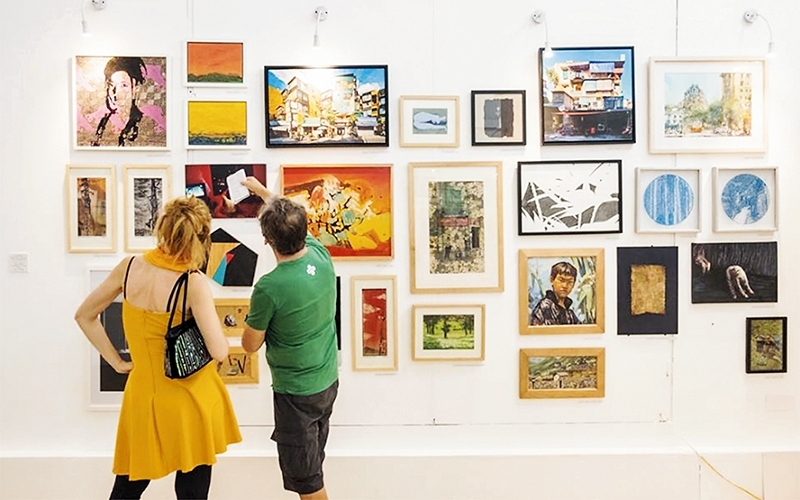As co-founder of the Manzi Art Space, Vu Ngoc Tram said that she hoped that the annual event will contribute to developing Vietnam’s fine art market.
 |
| Co-founder of Manzi Art Space, Vu Ngoc Tram |
Tram granted an interview to Nhan Dan Monthly newspaper to talk more about the programme and her effort to make art more accessible among the public.
How has the ‘Art for You’ programme been changed over its five editions?
Vu Ngoc Tram: The programme was held for the first time in 2014, gathering the participation of more than 100 artists. The event took place over several days within the small space of Manzi.
After five years, in the latest edition, ‘Art for You’ attracted over 200 artists with around 500 artworks. It was not only held in Hanoi with a larger scale but has also been organised regularly in Ho Chi Minh City. Works on sale include not only paintings but also sculptures. The number of acclaimed artists and young faces has also increased year on year.
Only one thing remains unchanged throughout the editions, which is the price of the art works, which ranges from US$25 to US$900.
Painter Nguyen Manh Hung often wants a bid of around US$1,500 for a small-sized water painting, but he agrees to offer the price of US$900 to support ‘Art for You’. At ‘Art for You’, the art-loving community can possess paintings by celebrated artists such as Le Cong Thanh, Tran Trong Vu, and Pham Khac Quang at a more manageable price than other places.
What’s about customers at ‘Art for You’?
Previously, foreigners accounted for 95% of customers at ‘Art for You’, however, more and more Vietnamese people have joined the event. What is heartening is that the number of visitors and people interested in ‘Art for You’, are particularly youngsters and university students. They might not be our customers today, but they will possibly be in the future.
We have set three key goals for the long-term project. First, ‘Art for You’ helps artists improve their income. Second, it provides funding for Manzi and Work Room Four’s organisation of our arts programmes. Third, it helps to bring arts to a wider audience.
What is the ratio of Vietnamese in your customers, according to your observation?
I see that the ratios of Vietnamese and foreign customers at ‘Art for You’ is 15% and 85%, respectively. Among them, youngsters account for 35% of the transactions and they show little hesitate during the trade. If they love it, they buy it. They can buy a painting at several hundred dollars. Meanwhile, there is remarkable number of those aged above 50 visiting the event, however, few of them get involved in the trading.
Can you share us some of the most impressive stories you have witnessed during the organisation of ‘Art for You’?
 |
|
In its latest edition, ‘Art for You’ programme attracted over 200 artists with around 500 artworks
|
Throughout the editions of ‘Art for You’, many parents have brought their kids to the events and let them choose paintings for their own room at home. The kids’ decisions are fully respected by their parents. I remembered that a foreign couple allowed their five-year-old son to choose his favourite painting, which was paid for with his savings over the past year. I think it is a practical way to help children grow more interest in the arts.
From your point of view, how can the authorities and managers contribute to the building of an authentic fine arts market and raise aesthetics among the people?
We are considering making a proposal to the Hanoi city authorities on the building of an art fair. As we have numerous talented artists, it is completely possible to organise the event annually. If our proposal is approved, we are willing to implement it, as long as the city’s authorities provide support concerning the location, legal documents, and initial investment.
Regarding the building of a fine art market and raising the public’s aesthetics, I think it is crucial to reform the way we educate fine arts at schools. We need more art spaces, museums, theatres, galleries, and public art projects in order to make art more accessible to the public.
Legal and financial support for art centres and a favourable environment which encourages art practitioners are also necessary to benefit both artists and the public.
Nhan Dan
 More than 2,000 artworks have been sold over the past five years under the ‘Art for You’ programme, which is co-organised by the Manzi Art Space and art studio Work Room Four.
More than 2,000 artworks have been sold over the past five years under the ‘Art for You’ programme, which is co-organised by the Manzi Art Space and art studio Work Room Four.